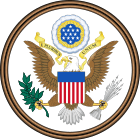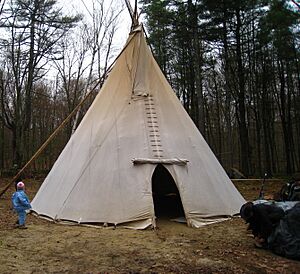Religious Freedom Restoration Act facts for kids
 |
|
| Long title | An Act to protect the free exercise of religion. |
|---|---|
| Acronyms (colloquial) | RFRA |
| Enacted by | the 103rd United States Congress |
| Effective | November 16, 1993 |
| Citations | |
| Public law | 103-141 |
| Statutes at Large | 107 Stat. 1488 |
| Codification | |
| Titles amended | 42 U.S.C.: Public Health and Social Welfare |
| U.S.C. sections created | 42 U.S.C. ch. 21B § 2000bb et seq. |
| Legislative history | |
|
|
| United States Supreme Court cases | |
|
|
The Religious Freedom Restoration Act of 1993, often called RFRA (pronounced "rifra"), is a United States federal law. It was created in 1993 to make sure that people's religious freedom is protected.
This law was passed because of a 1990 decision by the U.S. Supreme Court. The Court had ruled that if a law applies to everyone and doesn't specifically target a religion, it doesn't break the First Amendment to the United States Constitution. This was true even if the law made it harder for someone to practice their religion.
RFRA changed this. It requires that if a law makes it difficult to practice a religion, the government must have a very good reason for it. Also, the government must use the easiest way possible to achieve its goal without limiting religious freedom too much.
At first, RFRA applied to both state and federal laws. However, in 1997, the Supreme Court decided that it could not apply to state governments. It still applies to the federal government today. Because of this, many states have passed their own similar laws to protect religious freedom within their borders.
Contents
What Does RFRA Do?
This law brought back an important legal test called the "Sherbert Test." This test helps decide if a law goes against the Free Exercise Clause of the First Amendment. This part of the First Amendment guarantees religious freedom.
RFRA says that even a law that seems fair to everyone can still make it hard for someone to practice their religion. So, the law states that the government should not make it much harder for a person to practice their religion. This is true even if the difficulty comes from a rule that applies to everyone.
When Can the Government Limit Religious Freedom?
The law allows for an exception if two things are true. First, the government must have a "compelling government interest." This means the government's reason for the law must be very important, not just a small improvement. It must be about core constitutional issues.
Second, the rule must be the "least restrictive way" to achieve that important government goal. This means the government must choose the method that limits religious freedom the least.
Why Was RFRA Created?

The First Amendment says that Congress cannot make laws that stop people from freely practicing their religion. For a long time, the Supreme Court said this meant laws could not make it harder for someone to practice their religion.
However, in the 1980s, the Court started to allow laws that accidentally made religious activities difficult. This was okay as long as the law applied to everyone.
Impact on Native American Religions
These "generally applicable" laws often caused problems for Native American religious practices. For example, government projects sometimes needed land that was sacred for Native American rituals. Also, some traditional ceremonies involved the use of certain plants, which became an issue with general laws.
The American Indian Religious Freedom Act was passed to protect tribal religious freedoms. But it didn't have a strong way to make sure its rules were followed.
Important Court Cases
Two important court cases highlighted these issues: Lyng v. Northwest Indian Cemetery Protective Association (1988) and Employment Division v. Smith (1990).
In Lyng, Native American tribes argued that the government should not build a road through sacred land. This land was used for ceremonies and prayer. But the Supreme Court disagreed. It said that the First Amendment only stopped the government from forcing or punishing religious beliefs.
In Smith, the Court supported the state of Oregon. Oregon had refused to give unemployment benefits to two Native Americans. They had been fired from their jobs after using a plant in a religious ceremony.
How RFRA Became Law
The Smith decision made many people upset. Groups from different political views and religions agreed that the law needed to be changed. They wanted to bring back the "Sherbert Test."
In response, Congress passed the RFRA. The House of Representatives voted for it unanimously. The Senate passed it with a vote of 97 to 3. Then, U.S. President Bill Clinton signed it into law.
Challenges and Changes to RFRA

In 1997, a part of RFRA was overturned by the United States Supreme Court. A church in Boerne, Texas, wanted to make its building bigger. But a local rule protected the building as a historic landmark.
The church sued, using RFRA. In the case City of Boerne v. Flores, the Supreme Court decided that RFRA could not apply to state governments. The Court said that Congress had gone beyond its power.
What Happened After the Boerne Ruling?
After the Boerne ruling, Congress passed a new law in 2000. It was called the Religious Land Use and Institutionalized Persons Act (RLUIPA). This law gives special protections to religious landowners.
Many states have also passed their own state RFRAs. These laws apply the same rules to their own state laws. But in many states, the Smith case still guides decisions if there isn't a state RFRA.
RFRA and the Federal Government
The Supreme Court confirmed that RFRA still applies to the federal government. In 2006, in the case Gonzales v. O Centro Espírita Beneficente União do Vegetal, the Court ruled against the government. This case involved the use of a plant in a religious ceremony. The Court said the federal government must show a very important reason to limit religious actions.
After the Smith case, some Native Americans still faced issues using certain plants in their ceremonies. This led to the Religious Freedom Act Amendments in 1994. These amendments made it clear that using, having, or moving certain plants for traditional ceremonies by Native Americans is legal. It cannot be stopped by the U.S. or any state.
How RFRA Has Been Used
The Religious Freedom Restoration Act makes the federal government responsible for protecting religious practice. It means federal officers and agencies must follow RFRA.
By 1996, before RFRA was changed for states, it had been used in 337 cases. It was found that religions like Jewish, Muslim, and Native American faiths, which are a smaller part of the U.S. population, were involved in a larger share of cases about religious freedom.
Examples of RFRA in Action
RFRA was important in a challenge by six Native American tribes against the National Forest Service. The tribes, including the Navajo and Hopi, did not want a ski resort in Arizona to use reclaimed water to make artificial snow. They felt it would harm their sacred land and ceremonies. In 2008, a court rejected their RFRA claim.
In another case, Adams v. Commissioner, a woman argued that her religious beliefs meant she shouldn't have to pay federal income taxes that fund military spending. The U.S. Tax Court disagreed. It said that everyone must pay taxes, and this is a very important government interest.
RFRA was also a big part of the Supreme Court case Burwell v. Hobby Lobby in 2014. The Court decided that RFRA protects companies that are closely held by families, allowing them to have religious objections to certain rules.
See also
- Freedom of religion in the United States
- Reuben Snake

